Corned Beef Ireland Exported Too Expensive
The Untold Truth Of Corned Beef
Corned beef might seem synonymous with Saint Patrick's Day, but in reality, there's a lot less Irish and a lot more Jewish about corned beef than you might think.
From its origins in the Irish Middle Ages, when Food & Wine says it was seen as a food fit for kings (and not for the riff raff who were breaking their backs to produce it as tenant farmers) to its metamorphosis into the somewhat questionable "bully beef" — a canned version that provided much-needed sustenance to soldiers on the front during both World Wars, corned beef has a long and convoluted history (via Delishably). Was it invented in Ireland or on the Lower East Side of Manhattan? Is it actually Irish or is it Romanian? Is there actually corn in it? And do the Irish actually eat it on Saint Patrick's Day?
For the answers to these questions and more, read on. Corned beef will soon hold no secrets for you.
Corned beef is not that common in Ireland
While Irish-Americans are certainly gung-ho about corned beef (as well as other St. Paddy's Day traditions like green glitter and green beer), this stands in stark contrast with their homeland, where corned beef is far from as common as you'd think (and where, by the way, beer is amber or brown, not green.) Indeed, according to the Smithsonian, beef is not all that commonplace in the traditional cuisine of Ireland, where, historically, cattle were used not for meat, but for fieldwork or dairy production. Cows were usually only slaughtered for food once they were no longer able to do their assigned jobs.
In the time of tribal chieftains, the size of your cattle herd was a sign of your power. To slaughter one before it was necessary would have been madness — something that European Cuisines compares to setting money on fire.
So while European Cuisines says that salted or cured beef is indeed an Irish tradition dating back as early as 800 AD, with its first mention appearing in the 12th century poem "The Vision of MacConglinne," it was perceived as a luxury item, consumed only by the rich, like the king evoked in the poem, or, later, by foreigners who imported the high-quality product from Ireland. It was far from the rustic peasant fare we think of when we serve up a heaping plateful to soak up all that St. Paddy's Day beer.
Beef in general — and corned beef in particular — only became common in Ireland with the arrival of the English
While cattle have indeed long been present in Ireland, it wasn't until the conquest of Ireland by the English that beef became common in the region, according to Food & Wine. The British had been eating beef since Roman times and had developed quite a taste for it. Given the relatively small size of their island, however (in contrast with their beefy appetites), the Brits took advantage of their conquest of Ireland, Scotland, and even the North American colonies to raise cattle for slaughter. This meant that the Irish were soon farming more and more beef — but they were far too poor to partake in any of it.
According to the Smithsonian, the Cattle Acts of 1663 and 1664 were what truly spurred the Irish corned beef industry (via Technological University Dublin). The Acts forbade the export of live cattle from Ireland to Britain. Thanks to easy access to inexpensive, high-quality salt, which was taxed at a lower rate in Ireland than in England, the Irish were able to export huge amounts of salted beef to England, France, and the colonies.
There's nothing corn-y about corned beef
Despite what its name may lead you to believe, the secret to delicious corned beef isn't corn but salt. Indeed, Irish corned beef is a preserved meat product, made according to tradition by curing the meat in a large quantity of salt. The term corned beef was invented by the British in the 17th century, according to the Smithsonian: a reference, not to corn, but to the corn-sized salt crystals applied to the meat. This first iteration of the classic we all know and love today, the Smithsonian asserts, was saltier than it was beefy, but it was certainly a predecessor to the corned beef you see on modern tables.
These days, corned beef is a bit of a misnomer, at least when it comes to the contemporary iterations of the product. While giant "corns" of salt were indeed used in the original recipe, today, according to Westchester Magazine, salt brines are far more common. This also allows you to add flavor by way of spices such as allspice, mustard, coriander, pepper, cloves, or bay, according to Simply Recipes.
Corned beef and cabbage is an Irish-American tradition
Corned beef is less common in Ireland than you'd think, but it's certainly present. That said, one thing is for sure: the pairing of corned beef and cabbage is absolutely an Irish-American tradition.
Despite the popularity of Irish corned beef beginning in the 17th century, according to Food & Wine, most locals couldn't afford the luxury product. Indeed, European Cuisines notes that many Irish tenant farmers were raising and producing corned beef for export without ever having had a morsel of the sought-after meat pass between their lips. If the Irish could afford meat, it was usually pork, and special occasion meals on holidays like Easter, for example, saw cabbage paired, not with corned beef, but with salt pork or bacon.
Cut to the 1845 potato blight and resulting famine, which led about a million Irish people to leave the country, with many of them settling in the U.S. (via History). It was there that they finally began to make enough money to purchase corned beef (per The Kitchn, in America, the traditional Irish staple of pork bacon was too expensive for the new immigrants). By cooking local corned beef with familiar (and inexpensive) cabbage, they created the dish that has since become an Irish-American classic.
Back in Ireland, according to European Cuisines, one does occasionally find corned beef paired with cabbage on St. Patrick's Day, but pubs dishing it up are generally doing it for the tourists.
Corned beef might have some Jewish influence
While corned beef is certainly an Irish product — and corned beef and cabbage is certainly an Irish-American tradition — there may be one more community to thank for its popularity: the Jewish one.
Indeed, when the Irish first emigrated to the U.S. in the mid-19th century, they often found their way to the Lower East Side of Manhattan, an area that also welcomed Jewish immigrants (via My Jewish Learning). According to the essay "Irish Corned Beef: A Culinary History," evidence in popular songs from the turn of the 20th century indicates that the two communities felt a bond with each other. Westchester Magazine says that Irish immigrants began eating the Jewish version of corned beef at delis in New York City. It was this iteration of corned beef — and not the expensive exported stuff from their native Ireland — that found its way into the pots of the newly arrived Irish, according to the Smithsonian.
Corned beef comes from the brisket of the cow
The corned beef that we consume in the U.S. was inspired by the corned beef of Jewish butchers and is thus made with brisket: a cut hailing from the front or breast area of the cow, according to the Smithsonian. The corning or salting process transforms this tough yet flavorful cut into an ultra-tender piece of meat. It's no wonder this dish is so beloved.
But brisket is not the cut used for all corned beef. In Ireland, tradition called for silverside, a cut from the hindquarters of the animal. It's named for the silvery membrane that covers it, according to Simply Beef and Lamb. While this exact cut doesn't exist in the U.S. due to differences in butchery techniques, it vaguely corresponds to the American round, according to European Cuisines.
Tradition aside, the fact is that any tough, sinewy cut of beef could technically be transformed into corned beef, including, according to the Spruce Eats, the aforementioned round, or, per New England Today, the rump or tongue.
It's similar to — but not the same as — pastrami
The Jewish influence on the corned beef of today leads many to wonder about the differences between corned beef and another beefy Jewish deli counter offering: pastrami.
Per Spend with Pennies, the main difference between the two is the cut: corned beef, the outlet asserts, hails from the brisket, while pastrami comes from the deckle, a cut found in beef shoulder. Eater echoes this distinction, noting nevertheless that these days, pastrami can indeed be made with brisket, adding a level of cloudiness to this reasoning.
Perhaps more important than the cut used to make them is that the two beef products are seasoned and prepared differently. While Eater asserts that both begin with the same brine of salt and spices tinged with coriander, bay, and juniper, after brining, pastrami is coated with a spice mix that may contain black pepper, coriander, mustard seeds, fennel seeds, and occasionally fresh garlic, while corned beef is left plain. And whereas pastrami is cooked by smoking over hardwood, corned beef is stewed or boiled, making pastrami the far more flavorful of the two.
Corned beef is available in red and gray varieties
Within the wider category of corned beef, two iterations exist, differentiated by color: either red and gray. And while the latter might not sound particularly enticing, gray might actually appeal more to modern consumers looking for less processed offerings, a desire that, according to Science Direct, is indeed on the rise.
Red brisket is cured with a curing salt called Prague powder, which contains sodium nitrite, according to The Spruce Eats. This substance is a food additive and preservative that is used to keep cured meats fresh, but that may be linked to blood vessel damage and heart disease, according to the Mayo Clinic, and has been listed as a probable carcinogen by the World Health Organization.
The gray, version, meanwhile, which New England Today dubs the "authentic New England variety," is not cured with nitrite. It doesn't have the bright color of the red variety, as nitrites give red corned beef its distinctive hue, but it's just as flavorful.
Corned beef is the main ingredient in a Reuben sandwich
Aside from the classic pairing of corned beef and cabbage, the dish with which corned beef is most frequently associated is a Reuben. The sandwich (which boasts a somewhat contested origin story — and given its popularity, we can't say we're surprised) features corned beef piled on rye bread and smothered with sauerkraut, Swiss cheese, and Russian dressing. It's a staple of New York's Jewish delis, and it's not hard to see why.
According to Olivia's Cuisine, a true Reuben boasts a pleasant touch of heat thanks to the addition of horseradish and hot sauce to the mayo-ketchup hybrid Russian dressing. This is a stark contrast to the sweeter flavor imparted by the similar Thousand Island, to which pickled relish is added. Swap the corned beef for pastrami, and you've got yourself a Rachel, or opt instead for turkey for a lower-calorie variation on the theme.
Source: https://www.mashed.com/738103/the-untold-truth-of-corned-beef/
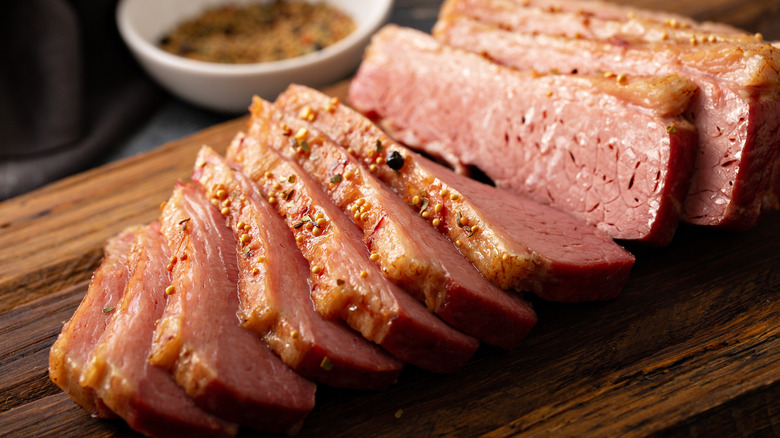

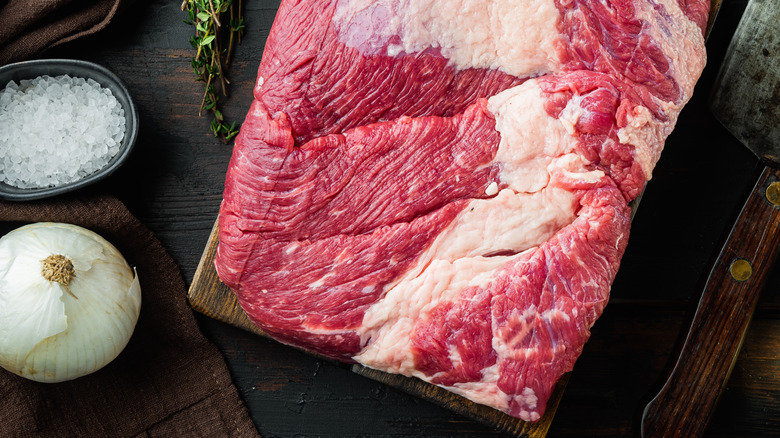
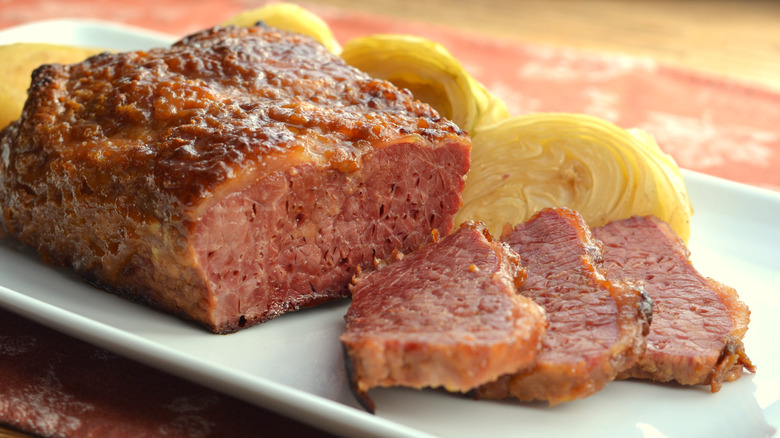
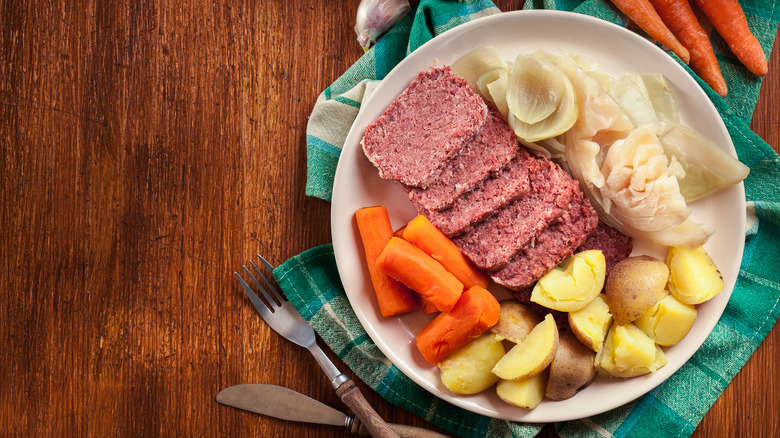
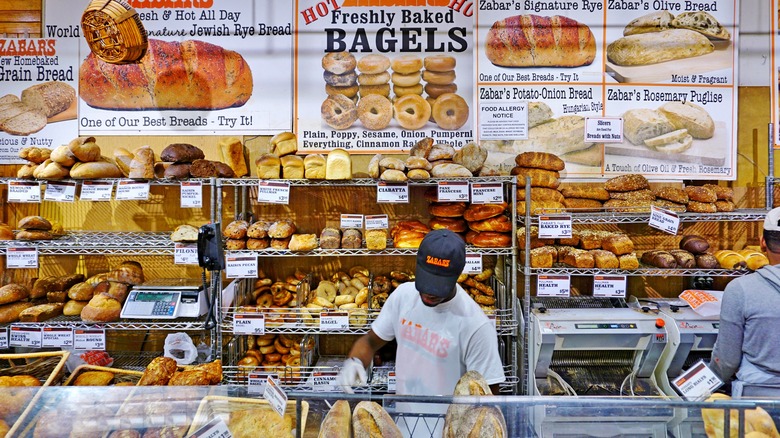
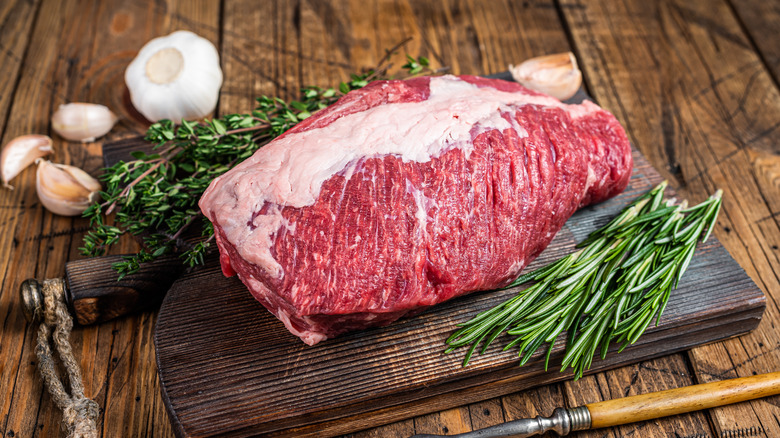
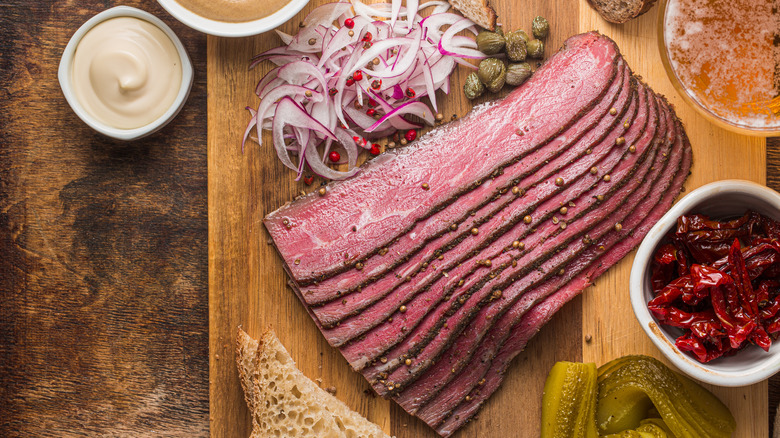
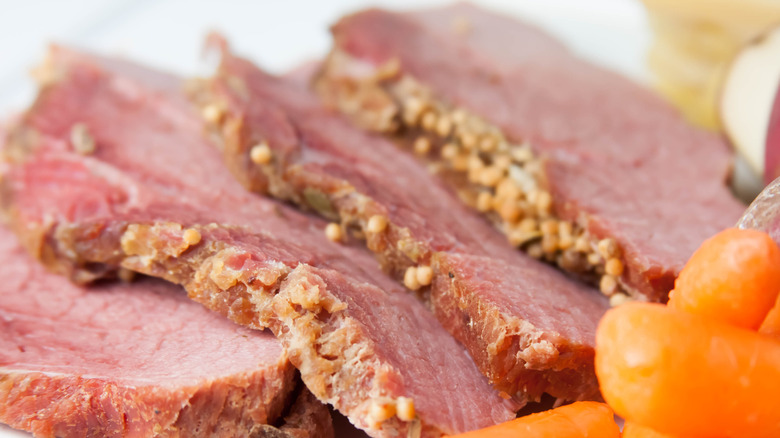
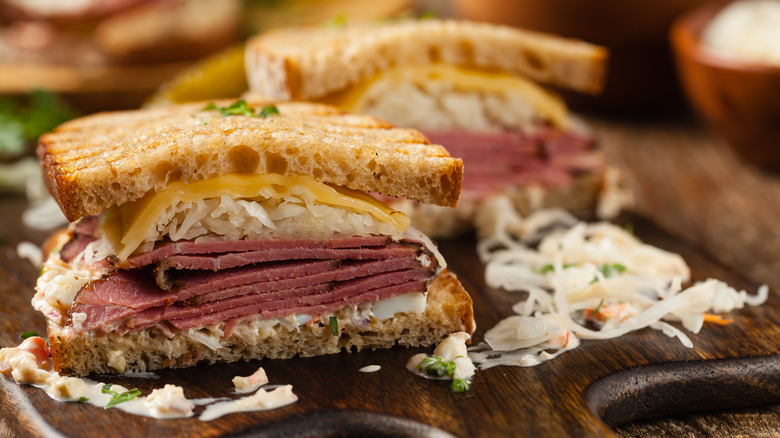
0 Response to "Corned Beef Ireland Exported Too Expensive"
Post a Comment